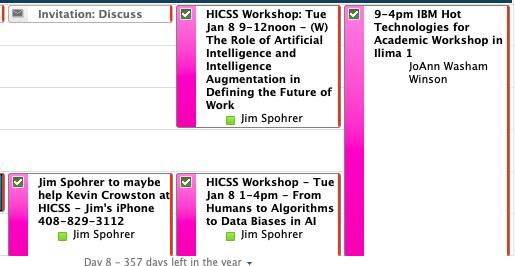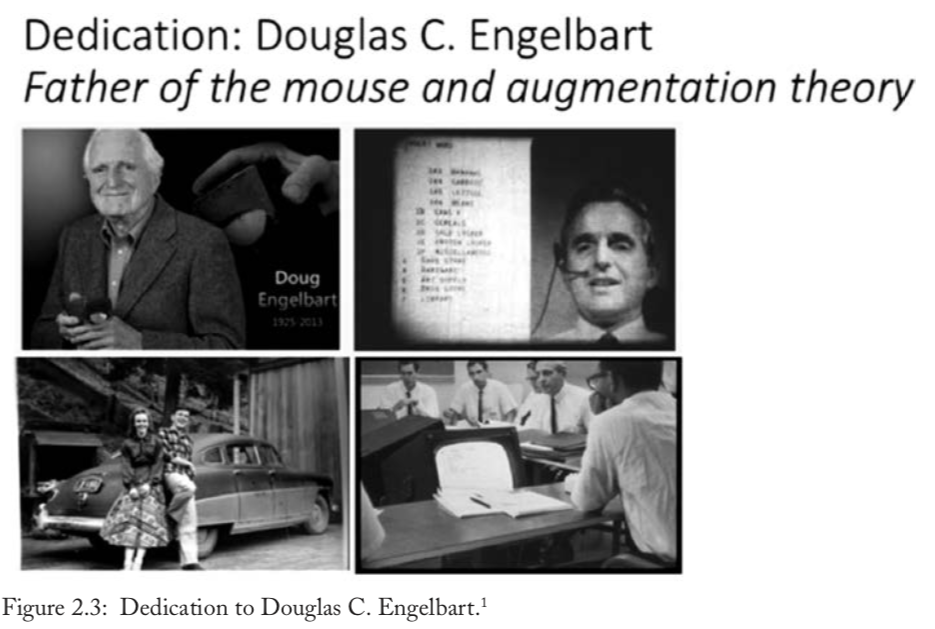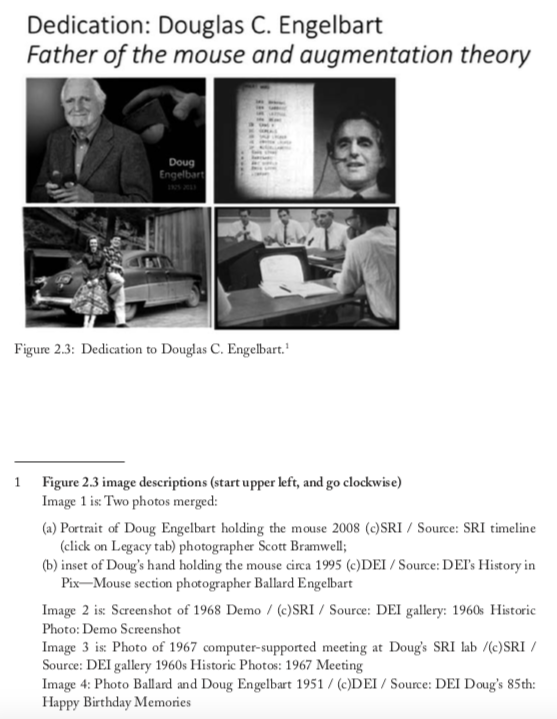Dr. Florin G. Filip recently sent two presentations to me. The two presentations are regarding decision support systems (Florin 2018a, 2018b). This short blog posts provides my summary of the presentations, but for more information about computer-supported collaborative decision-making see the Springer book (Filip, Zamfirescu, Ciurea 2017).
Both presentations that were shared with me by Dr. Florin G. Filip this week are now posted on-line with his permission (see references below).
Here is a quick summary of the shorter presentation (Filip 2018a) :
Slide 3: Table comparing face-to-face meeting and computer-supported-group-work.
Slide 4-7. Images of a variety of systems over the decades, starting with Engelbart’s vintage 1960’s AUGMENT system, and ending with a systems at Arizona State University, all citing Schuff et. al. (2011).
Slide 8. The image of the book cover (Filip, Zamfirescu, Ciurea 2017).
Here is a quick summary of the longer presentation (Filip 2018b):
Slides 1-3: In 1967, Peter Drucker picture and quotes – computers as useful morons.
Slide 4: In 1986, Umberto Eco quote: “The computer is not an intelligent machine that helps the stupid people , but is a stupid tool that functions only in the hands of intelligent people.”
Slides 5-6: Dr. Filip begins to suggest that maybe computers are getting smarter… and this needs to be explored.
Slides 7-8: 1951, Fitts perspective on what men are best at and what computers are best at
Slides 9-14: Exploration of automation of work by machines – especially for physical tasks in manufacturing, and automated, routine decision-making for making physical things
Slides 15-18: Initial exploration of beyond automation to collaboration – work by people and machines together, including slide 18 definition of DSS (Decision Support System) by Filip in 2008 as “An anthropocentric and evolving information system which is meant to implement the functions of a human support system that would otherwise be necessary to help the decision-maker to overcome his/her limits and constraints he/she may encounter when trying to solve complex and complicated decision problems that count “
Slides 18-24: The rise and evolution of DSS (Decision Support Systems)
Slides 25-40: The rise of data-driven DSS and Big Data and Business Intelligence (BI) ,with some example.
Slides 41-45: The rise of Cloud Computing (and observation that is similar to the mainframe days, just with much, much better bandwidth).
Slides 46-49: Putting it all together where iDSS (Intelligence Data Support Systems) emerge in business and society, along with Big Data as a Service.
Slides 50-63: From HA Simon and the origins of Artificial Intelligence (AI), to JCR Licklider early Cognitive Systems (Symbiosis, Intelligence Augmentation), to IBM Watson Cognitive Computing (Intelligence Augmentation), Spohrer’s Cognition-as-a-Service AI Magazine paper.
Slides 63-66: Present some words of caution as well as a balanced view of the benefits and the risks of the resurgence of AI. From Drucker’s Morons to Simon/Licklider/Engelbart/IBM’s AI/IA – Smart. Computers have gone from morons to smart in a little over six decades.
Slides 67-73: Multi-criteria decision-making to choose cognitive tools that have attributes needed to do the right things in the right way.
Slide 74: Filip’s concluding remarks: ” (1) BI&A make more effective the Intelligence phase of the decision –making process model of H. Simon, (2) Mobile computing makes possible locating and calling the best experts to perform the evaluation of alternatives, (3) Cloud computing enables complex computation during the Choice phase, (4) Cognitive systems can be effective in the Choice phase, (5) Social networks enable crowd problem solving, (6) The combination of Cloud computing and BI&A is the solution for Big Data problems.”
Slide 75-78: Filip presents the references cited in the presentation and a closing picture.
First the two presentations got me thinking about meetings.
The Study of Meetings – People Collaborating to Make Decisions and Explore Topics Together: Meetings are an interesting phenomena to study. Not sure what the definitive work to cite is for meetings. Based on a quick scan of Google Scholar, the literature is vast and diverse – from studies of face-to-face governance meetings in different cultures to running effective meetings in business to meetings designed to achieve specific outcomes, such as making a decision and handing out new assignments, meetings can also be to provide updates on past accomplishments or celebrations of what has been achieved.
I started thinking about meeting as an interesting form of collaboration when I was viewing the two presentations sent to me by Dr. Florin G. Filip. His presentations includes an interesting collection of images of meeting rooms designed with a computer for every person in the meeting. In fact, the third slide of (Filip 2018a) is entitled “Face-to-face Meetings vs Computer Supported Group Work.” A number of attributes of both types of meetings are identified and compared in a table, and not surprisingly the face-to-face meetings are more verbal communication means and the computer support group work is more written, but both have an audio and visual components.
Our correspondence originated when I was invited to present in Omaha, Nebraska last October at the ITQM conference where I received the “Daniel Berg Service Systems” award. The presentation that I presented at ITQM can be found here, and included several sections: Slide 5 summarizes the case for Service Systems Engineering (Tien & Berg, 2003); Slides 6-11 summarize the work at IBM on Service Science inspired by many sources including the (Tien & Berg, 2003); Slide 12 sets up the rest of the presentation by noting that our data is becoming our AI, and this is part of a larger business and societal transformation in which all service system entities (individual people, businesses, cities, states, even nations) will be transformed as their data becomes their AI; Slides 13-23 provide some useful concepts, such as physical-symbol-system and computers to serve society from Computer Science (Newell & Simon, 1976), Service-Dominant Logic’s concepts of service and resource-integrator (Vargo & Lusch, 2004), Service Science’s concepts of service science and service systems (Maglio & Spohrer, 2008), and more recent fascination of the service research field with the implications of AI; Slides 24-28 suggest that AI is at the peak of the hype cycle, but there is certainly something going now with AI worth of attention.
Slide 29 lays out some important questions that presentation tries to provide some answers to as well: (1) What is the timeline for solving AI and IA?, (2) Who are the leaders driving AI progress? •What will the biggest benefits from AI be?, (3) What are the biggest risks associated with AI, and are they real?, (4) What other technologies may have a bigger impact than AI?, (5) What are the implications for stakeholders?, (6) How should we prepare to get the benefits and avoid the risks?
Slides 30-33 present evidence based on computing power and open source leaderboards (data and challenges) that narrow AI will be solved in about twenty years (by 1940) and general AI will be solved in about forty years (by 2060).
Slide 34-39 presents some evidence about who is winning in AI by nation on publications (China, with USA in second place), by company on publications (Microsoft, with Google catching up), and by patents (IBM), and by nation by number of robots (South Korea).
Slide 40 presents the major benefits of AI: (1) increased productivity, and (b) improved collaborations.
Slide 41 present the major risks of AI, both exaggerated by media, as well as what is real today: (1) job loss exaggerated, real today de-skilling, and (2) super-intelligence exaggerated, real today bad actors using AI for mischief.
Slide 42 presents other technologies that will have a bigger impact than AI on quality of life of people in the next twenty years, including (1) Augmented Reality (AR) and Virtual Reality (VR) as games grow-up from entertainment to education and business/commerce, (2) Blockchain for trust in a world where AI can create fake things that look real, (3) Energy and Material Advances will provide exo-skeletons for the elderly, and we are all aging, and (4) not explicitly mentioned, but a challenge to the audience is to name the fourth and possibly largest technology that will impact quality-of-life in 20 years, and that is BioChemical Engineering, including the work on human micro biome for heatlhier living.
Slides 43-49 provide more details about the impact across industries of (a) transportation with vehicles that drive themselves, (b) cities recycling 99% of water, (c) local manufacturing as a recycling service with robots and 3D printers (also VTT innovation of protein from air to reduce carbon/climate change, and exoskeletons for elderly), (d) no energy shortages due to artificial leaf (hydrogen) and geothermal (better drilling), (e) rapid construction and recycling of advanced buildings (e.g., Broad Group in China, 30 story building built in 15 days), (f) narrow AI solved for digital workers, (g) retail social filtering, (h) finance crowd funding, (i) healthcare all robotic surgery and 3D printed organs, (j) education as team sport entrepreneurship, (k) and even government works better in twenty years thanks to AI’s help in balancing improve strongest and improve weakest link policies.
Slide 50-53 presents how to prepare by understanding open techologies and how to contribute GitHub, Kaggle (leaderboard challenges), 3 R’s (read, redo, report), and taking advantage of accelerating change to manage more and more digital workers in your life. When I grew up on a farm in Maine in the late 1950’s we had a party line telephone on the farm, in a wooden box on the wall, by 1970’s at MIT, I had a rotary dial phone in my dorm room on a long cord that could reach into the commons room, by 1990’s when I got to Silicon Valley, I had a mobile Nokia phone, and today I have my iPhone smartphone, and what will I have in 20 more years if I am lucky enough to make it to 80 years old, or in 40 years if I am lucky enough to make it to 100 years old? The building blocks are getting better. I wrote my first computer program on punch cards in 1972 (I am looking at the card in my office at IBM now as I write this blog post), and by 2016, leading IBM’s global universities programs, IBM had given 300,000 faculty and students worldwide free access to our IBM Cloud and Watson/AI computing capabilities. The building blocks have surely gotten better. Slide 52 shows winners of a first IBM competition for undergraduate university students – they used Watson to build a cognitive assistant to help homeless people and won a $100K prize, and Slide 53 shows an newspaper article of high school students in Californa who used Watson to win a programming contest by building an app to help fight local injustice crimes.
Slide 54 – 57 emphasize how important data is to building AI systems, and that our data is becoming our AI. Ten million minutes of experience to go from child to adult, and two million minutes of experience for a novice adult to become expert professional at many jobs, and that value is migrating from hardware to software to data to experience to transformation. Transformation is where all future value lies because people, businesses, nations, and all service system entities want to transform into their best possible future versions of themselves – value in transformation. The courses today help people learn how to build cognitive systems, but in a few years that will be easy, and so the courses will be about using cognitive systems to be better professionals, and then to use cognitive assistants/mediators to build startups, and eventually to managing your workforce of digital workers. My old farm in Maine had about 100 apple trees to provide income from biological workers (apple trees), and in the future people will have a 100 digital works to provide income from digital world of data.
Slide 58-64 tell the story of better building blocks with an example of image recognition getting better and better, and eventually becoming super-human – like recognizing the bread of a dog, or a leaf off a tree.
Slide 65-67 gives the example of how occupations will be staying (not going away), but tasks will be changing, as we can count on digital workers to help us with tasks that are impossible without them. Like reading 60,000 papers in multiple languages, and summarizing that to what we really need to know to make the right decisions about what to work on next, if we are a biochemical engineering working on finding new cancer fighting drugs. Ultimately, all occupations look like managing a workforce of digital workers, and all people appear to creating value for themselves and other by transforming to higher value future versions of themselves.
Slide 68-74 emphasize the importance of open source code, data, and models in the future – and why understanding GitHub, Kaggle, and CODAIT.org are so important.
Slide 75-76 emphasize that service science and opentech AI have trust in common, and that bad things will continue to happen, but people will get better and better at resilience – rapidly rebuilding from scratch.
Slide 77 – 78 are a reminder of what super-human AI capabilities will be all around us – the example of me finding a leaf on the ground in Evanston, IL and using AI to tell me that it is from a elm tree.
Slide 79 is the proposal for funding the first AI conference.
Slide 80-93 Are Fred Reiss’s keynote at ApacheCon about CODAIT and the growing importance of open source AI for the enterprise (large businesses).
Slide 94 is the close slide, an invitation to visit IBM Almaden in San Jose, CA.
Side 95-109 emphasize the importance of being part of a professional association and offer ISSIP.org (the International Society of Service Innovation Professionals) as one that has no charge to join, with over 1000 members in countries around the world, who have an interest in advancing service innovation for business and society. Service Science and Opentech AI are important to the future.
References
Filip FG, Zamfirescu BC, Ciurea C (2017) Computer-Supported Collaborative Decision-Making. Springer.
Filip FG (2018a) DSS: Classifications, Trends, and Enabling Modern I&C Technologies. 2018 Dec 26 URL: https://www.slideshare.net/spohrer/sofa-dss-classification-v24
Filip FG (2018b) DSS – An Evolving Class of Information Systems �or �(The Computer: from Peter Drucker’s Moron to Cognitive Systems)�. 2018 Dec 26 URL: https://www.slideshare.net/spohrer/damss-scurt-v2-dss-an-evolving-class
Schuff D Paradice D, Burstein F,Power D J, Sharda R eds (2011) Decision Support : An Examination of the DSS Discipline. Springer, New York:
Spohrer JC (2018) Open Technology, Innovation, and Service System Evolution. ITQM 2018 Keynote, Omaha NE USA. 2018 Oct 20 URL: https://www.slideshare.net/spohrer/itqm-20181020-v2
Cite this blog post as: Spohrer JC (2018) Perspectives on Decision Support Systems: Summary of FG Filip’s Presentations. 2018 Dec 26 URL: https://service-science.info/archives/5066


